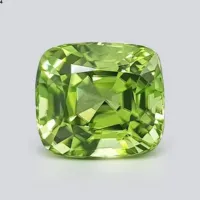Peridots, an attractive green gemstone, has been admired and loved throughout history. Its vibrant colors, unique origins and geological significance make it one of the most sought after gems in the world. This blog looks at the different types of peridot, their origin, their colors and why this gem is valuable today.
Table of Peridot Types, Origins, Mines, and Colors
| Type of Peridot | Origin | Mines | Color Range |
| Pakistani Peridot | Pakistan | Kohistan, Gilgit | Dark olive green, lime green |
| Chrysolite Peridot | Egypt, Myanmar, USA | Zabargad Island, San Carlos, Arizona | Yellowish-green, olive green |
| Forsterite Peridot | Pakistan, Norway, China | Kohistan, Norway | Pale green, dark green, olive green |
| Olivine Peridot | Hawaii, Australia | Hawaiian Volcanoes, Australian Mines | Bright green, yellowish-green |
| Burmese Peridot | Myanmar | Mogok Valley | Deep green, pure green |
| Arizona Peridot | USA (Arizona) | San Carlos Apache Reservation | Golden-green, lime-green |
Description of Peridot Types and Their Origins

Pakistani Peridot
Pakistani peridot is found in the mountainous regions of Kohistan and Gilgit, which produces some of the darkest and most vibrant olive green stones. These gemstones are highly valued for their special color and clarity.
Source: International Gem Society, GIA

Chrysolite Peridot
One of the oldest known types of peridot, chrysolite originated in Egypt, specifically on the island of Zabargad in the Red Sea. Known for its olive green hues, this type of peridot was loved by ancient civilizations. Its historical significance and color continue to make it popular among collectors and jewelers today.
Source: GIA, Gem Society
Forsterite Peridot

Found mainly in Pakistan, Norway and China, forsterite peridot is known for its pale green to olive green color. The Kohistan region of Pakistan has produced some of the finest forsterite peridots, especially prized for their clarity and deep green hues.
Source: International Gem Society, National Gemstone
Olivine Peridot

This type of peridot is commonly found in volcanic regions such as Hawaii and Australia. The formation of olivine peridot is closely related to volcanic activity, resulting in bright green and yellow-green hues.
Source: Jewelry Notes, GIA
Burmese Peridot

Originating from the famous Mogok Valley in Myanmar, the Burmese peridot is known for its rich, deep green color. These stones are among the highest quality peridots, often used in high-end jewelry.
Source: Gemstone.org, GIA

Arizona Peridot
Known for its gold and lime green hues, Arizona peridot is mined on the San Carlos Apache Reservation. It is one of the most affordable types of peridot in the United States, and its unique color makes it highly sought after by jewelers.
Source: Gem Society, National Gemstone
History and Significance of Peridot
Peridot has a long and distinguished history. It is one of the few gemstones that comes in only one color, and its distinctive green hue is due to the presence of iron in its structure. The oldest known peridots were discovered on the volcanic island of Zabargad in Egypt, where they were called the “pearl of the sun”. These gems were believed to protect the use of evil spirits and were often used in ancient talismans.
In medieval Europe, peridot was brought by the Crusaders and used to decorate religious objects. Its association with light and the sun gave it a mystical appeal during this time, and it was believed to dispel negative energy and bring good luck to those who wore it.
Today, the peridot remains highly valued for its beauty and symbolism. The birthstone of August represents strength, luck and protection. The gem’s connection to the inner layers of the Earth, formed in extreme volcanic conditions, also adds to its appeal.
Why Peridot Has Value
Peridot’s vivid green color, rarity in certain regions and historical significance contribute to its value. Unlike many gemstones, peridot is rarely treated to enhance its color, making its natural beauty a remarkable feature. In addition, peridot’s hardness (rated 6.5 to 7 on the Mohs scale) makes it ideal for use in a variety of jewelry, from rings to pendants.
The purity of peridot, especially those mined in Burma, Pakistan and Arizona, has made it a favorite among collectors and jewelry designers. Its unique formation, located in the Earth’s mantle and brought to the surface by volcanic activity, makes it one of the few gemstones with such a deep connection with the natural forces of the Earth.
Frequently Asked Questions (FAQs)
- What is the significance of Peridot?
Peridot is known for its unique olive-green color and has been historically associated with protection and good fortune. It is also the birthstone for August. - Where is Peridot found?
Major sources of Peridot include the USA (Arizona), Myanmar (Burma), Pakistan, and China. - Is Peridot durable for everyday wear?
With a hardness of 6.5–7 on the Mohs scale, Peridot is durable enough for regular wear but should be treated with care to avoid scratches. - What causes Peridot’s color?
The green color of Peridot is due to the iron content within the stone, which gives it a unique yellowish-green to olive-green hue.
Conclusion
Peridot is not only a beautiful green gemstone, but also a stone with a rich history and deep meaning. From the mines of ancient Egypt to the volcanic regions of Hawaii and Pakistan, peridot continues to fascinate with its natural beauty and vibrant color. Durability, variety of colors and historical significance make it one of the most valued gems in the world today.

